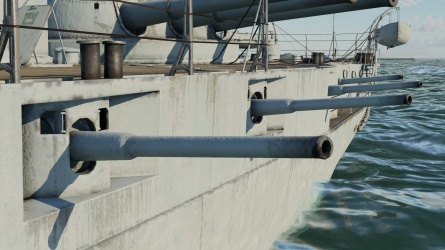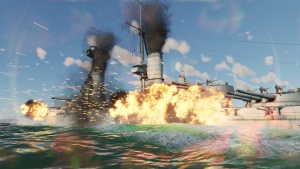152 mm/45 Schneider model 1911 (152 mm)

Contents
Description
152 mm/45 Schneider model 1911 is an Italian casemate secondary gun. Typically, for a gun designed before the First World War it struggles with rate of fire, muzzle velocity and targeting speed. But it holds a really good explosive filler. Historically, the gun was adopted from France and lacked any significant successes in combat.
Vehicles equipped with this weapon
General info
Typically, for dreadnoughts of the era, the 152 mm/45 is a casemate gun, with an extremely limited angles of fire, in particular vertical guidance, which tops at 16°. This is due to the fact that the designers expected to fight battles at a much closer ranges than during the World War Two, as the primitive fire directors struggled with distant targets. Still, in game the gun can reach targets at over 12 kilometers range, making it suitable for any typical engagement. The large explosive filler of the shells gives it significant burst damage, but the low rate of fire makes it possible to fire only two broadsides while the main guns are reloading.
Available ammunition
| Penetration statistics | |||||||
|---|---|---|---|---|---|---|---|
| Ammunition | Type of warhead |
Penetration @ 0° Angle of Attack (mm) | |||||
| 1,000 m | 2,500 m | 5,000 m | 7,500 m | 10,000 m | 15,000 m | ||
| HE Dirompente | HE | 44 | 44 | 44 | 44 | 44 | 44 |
| APHE Perforante | APHE | 199 | 164 | 120 | 90 | 70 | 55 |
| APHE Perforante da 152/45-50 | APHE | 198 | 164 | 120 | 90 | 69 | 55 |
| Shell details | ||||||||||||
|---|---|---|---|---|---|---|---|---|---|---|---|---|
| Ammunition | Type of warhead |
Velocity (m/s) |
Projectile mass (kg) |
Fuse delay (s) |
Fuse sensitivity (mm) |
Explosive mass (TNT equivalent) (kg) |
Ricochet | |||||
| 0% | 50% | 100% | ||||||||||
| HE Dirompente | HE | 830 | 46.3 | 0 | 0.1 | 5.4 | 79° | 80° | 81° | |||
| APHE Perforante | APHE | 830 | 47.1 | 0.03 | 7 | 2.62 | 47° | 60° | 65° | |||
| APHE Perforante da 152/45-50 | APHE | 830 | 47 | 0.03 | 7 | 3.1 | 47° | 60° | 65° | |||
Comparison with analogues
HE
| Cannon | Sample Ship | Ammo | Calibre (mm) |
Muzzle Velocity (m/s) |
Sustained rate of fire (rounds/min) |
Targeting speed (°/s) |
TNT Equivalent (kg) |
Penetration @ 0° Angle of Attack (mm) | |||
|---|---|---|---|---|---|---|---|---|---|---|---|
| Horizontal | Vertical | 5,000 m | 10,000 m | ||||||||
| |
152 mm/45 Schneider model 1911 | RN Andrea Doria | HE | 152 | 830 | 3.5 | 2 | 3 | 5.4 | 44 | 44 |
| 150 mm/45 SK L/45 | SMS Kaiser | HE | 150 | 835 | 7 | 4.2 | 4.2 | 1.6 | 21 | 21 | |
| 130 mm/50 pattern 1913 | Imperatritsa Mariya | HE | 130 | 823 | 8 | 3.4 | 3.4 | 3.9 | 37 | 37 | |
| 6-inch/45 Type 41 | IJN Settsu | HE | 152 | 825 | 5 | 4.2 | 4.2 | 5.28 | 43 | 43 | |
| 138.6 mm/55 model 1910 (138.6 mm) | Paris | HE | 138.6 | 840 | 6 | 4.2 | 4.2 | 3.1 | 36 | 36 | |
SAP / AP
| Cannon | Sample Ship | Ammo | Calibre (mm) |
Muzzle Velocity (m/s) |
Sustained rate of fire (rounds/min) |
Targeting speed (°/s) |
TNT Equivalent (kg) |
Penetration @ 0° Angle of Attack (mm) | |||
|---|---|---|---|---|---|---|---|---|---|---|---|
| Horizontal | Vertical | 5,000 m | 10,000 m | ||||||||
| |
152 mm/45 Schneider model 1911 | RN Andrea Doria | AP | 152 | 830 | 3.5 | 2 | 3 | 2.62 | 120 | 70 |
| |
152 mm/45 Schneider model 1911 | RN Andrea Doria | AP da 152/45-50 | 152 | 830 | 3.5 | 2 | 3 | 3.1 | 120 | 69 |
| |
120 mm/50 Armstrong model 1909 | RN Dante Alighieri | SAP | 120 | 850 | 6 | 7.7 | 6.4 | 2.2 | 61 | 31 |
| 5-inch/50 Mk.5 | USS North Dakota | SAP | 127 | 914 | 7 | 8.5 | 10 | 0.78 | 70 | 42 | |
| 5-inch/50 Mk.5 | USS North Dakota | AP | 127 | 914 | 7 | 8.5 | 10 | 0.77 | 116 | 69 | |
| 150 mm/45 SK L/45 | SMS Kaiser | SAP | 150 | 835 | 7 | 4.2 | 4.2 | 1.05 | 61 | 37 | |
| 150 mm/45 SK L/45 | SMS Kaiser | AP | 150 | 835 | 7 | 4.2 | 4.2 | 0.99 | 153 | 93 | |
| 130 mm/50 pattern 1913 | Imperatritsa Mariya | SAP | 130 | 823 | 8 | 3.4 | 3.4 | 1.67 | 115 | 71 | |
| 6-inch/45 Type 41 | IJN Settsu | AP | 152 | 825 | 5 | 4.2 | 4.2 | 1.88 | 123 | 74 | |
| 138.6 mm/55 model 1910 | Paris | SAP Mle 1910 | 138.6 | 830 | 6 | 4.2 | 4.2 | 2.93 | 34 | 34 | |
| 138.6 mm/55 model 1910 | Paris | SAP Mle 1921 | 138.6 | 790 | 6 | 4.2 | 4.2 | 2.93 | 47 | 34 | |
Usage in battles
For a secondary casemate gun, the 152 mm/45 Schneider model 1911 is a relatively good performer. While the rate of fire leaves a lot to be desired, one can fire a two full broadsides while the main guns are reloading, allowing one to efficiently deal with lighter targets, such as the destroyers or cruisers. It's ill-advised to use these guns against most of the coastal vessels - while historically this was one of the primary reasons for their existence, in reality it's best to leave these targets for the anti-air guns that have a much better rate of fire.

Pros and cons
Pros:
- Excellent explosive filler
- Very good penetration of the AP shells
Cons:
- Low rate of fire
- Poor targeting speed
- Low muzzle velocity
History
The Dreadnought arms race of the early 20th century led Italy on staying competitive. When designing their ships, they not only looked east to Austria-Hungary but also west to France as, despite nominal alliances, both nations were regional powers in the Mediterranean where the Regia Marina (Royal Italian Navy) operated. The Andrea Doria-class dreadnoughts, ordered in response to the French Bretagne class, were more or less similar in design to the earlier Conte di Cavour-class dreadnoughts, but one of the significant changes of the design was upgrading the secondary armament to the 152 mm cannon. The 152 mm/45 Schneider model 1911 was adopted from France the same year with Ansaldo soon beginning licensed production. These are the guns that would be used to arm RN Andrea Doria and her sister ship RN Duilio.
In service, the guns rarely saw actual combat which was likely a blessing in disguise. Being positioned on the sides of the hull underneath the 12-inch Vickers model 1909 main gun battery, the guns tended to get wet in heavy seas, particularly the rear guns. Both Andrea Doria-class dreadnoughts sat out most of World War I, mostly patrolling the southern Adriatic Sea while waiting for a decisive engagement with the Austro-Hungarian Navy that never happened. After the war, RN Andrea Doria saw some action participating in the bombardment of the Greek island of Corfu in 1923 after the murder of an Italian general and his two aides who were attempting to mediate a border dispute between Greece and Albania. Her sister ship Duilio also participated in this 1923 bombardment along with supporting the White Russians in the Black Sea in June and July of 1919. In 1937, the dreadnoughts went through a modernization program where the 152 mm guns were replaced with 135 mm guns in response to their ineffectiveness. When the following Franceso Caracciolo-class dreadnoughts were canceled thanks to the outbreak of World War I putting new capital ships on the backburner in favour of large numbers of smaller craft like destroyers, the Andrea Doria-class became the only class of ships completed with these guns. The next class of battleships Italy built, under the restrictions of the 1922 Washington Naval Treaty, was the Littorio class and was armed with more modern 152 mm guns from the final series of Condottieri-class light cruisers.
Alongside their role as naval guns, the 152 mm/45 was used as coastal defense guns and even siege artillery. When the modernization programs removed the 152 mm/45 guns from the Andrea Doria-class, the guns were reused in these roles. The coastal defense guns would serve through both world wars in the Regia Marina. The use of these guns as siege artillery came from the pressing need for such weapons in the Regio Esercito (Royal Italian Army) fighting on the Alpine Front. Surplus barrels were mounted on a standard box trail carriage with a large open section to allow the breech to recoil. 53 guns were still in service in Northern Italy in 1943. After the signing of the Italian Armistice in 1943, some guns ended up in German service where they were designated 15.2 K 411 (i).
Media
Excellent additions to the article would be video guides, screenshots from the game, and photos.
See also
- 120 mm/50 Armstrong model 1909 earlier secondary gun used on RN Dante Alighieri
- 152/53 mm Ansaldo model 1926 another Italian 152 mm gun, used on early cruisers
- 152/53 mm O.T.O. model 1929 third Italian 152 mm gun, also used on cruisers
- 135 mm/45 O.T.O. Mod. 1937 successor to the secondary guns used on Italian battleships
External links



